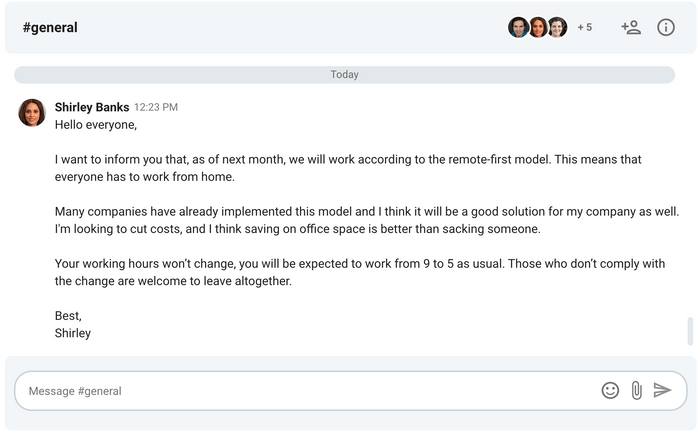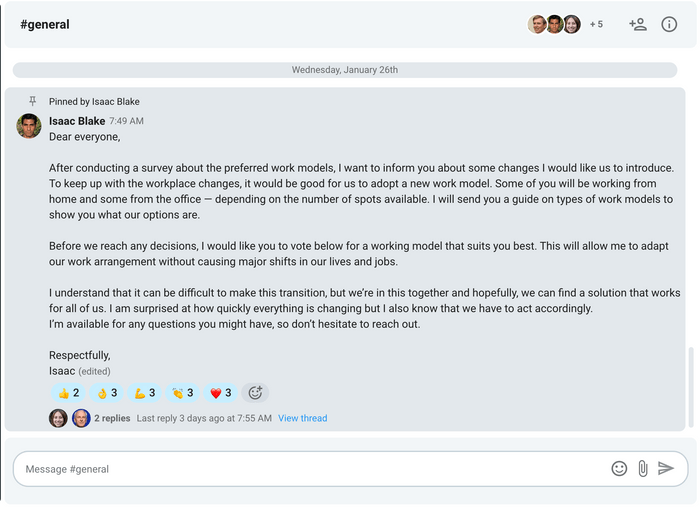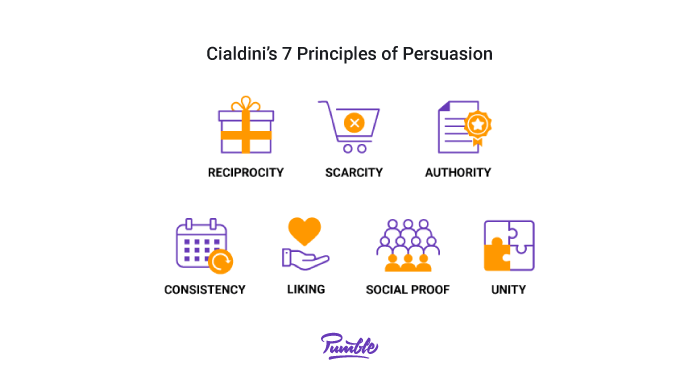Have you ever wondered how it’s possible that some people are natural at persuasion while others could spend a lifetime trying to negotiate something and still fail?
Why are we prone to immediately saying “Yes” to some people?
The answer is simple — it’s because they are persuasive communicators.
In this blog post, we’ll discuss persuasive communication and its importance in the workplace through examples.
We’ll also list the most important persuasive communication skills you should work on and provide you with helpful strategies to do that.
So, let’s start.
Table of Contents
What is persuasive communication?
The Encyclopedia of Human Behavior states that “persuasive communications contain a variety of attributes intended to enhance persuasion, which could include an attractive source, a message containing convincing arguments, or efforts to make the topic seem personally relevant to the audience.”
Back in 2003, Richard M. Perloff, an American academic and professor of communication at Cleveland State University, defined persuasion as “a symbolic process in which communicators try to convince other people to change their attitudes or behavior regarding an issue through the transmission of a message, in an atmosphere of free choice.”
So, persuasive communication can be a powerful and effective tool for achieving goals, both in internal and external business operations:
- When communicating with colleagues: Persuasive communication is vital for establishing a mutually cooperative working relationship with your team and teammates. This also applies to multi-generational and cross-cultural teams.
- When communicating with managers and team leads: Persuasive communication can help get important messages across to your boss or manager.
- When communicating with clients and customers: Persuasive communication allows you to convince your clients and customers that you’re the best person for the job.
Need a stellar communication app? Try Pumble
Why is persuasive communication important in the workplace?
Perloff says that the way persuasion is used today has evolved so much, it’s practically inevitable in daily life. In his book, “The Dynamics of Persuasion: Communication and Attitudes in the Twenty-First Century”, he explains that:
- Persuasion is a serious business: While there are businesses that exist only for persuasive purposes (advertising agencies, marketing companies, PR firms, etc.), many others also rely on persuasion to sell their products and services.
- Persuasion is more common: An average person encounters between 6,000 and 10,000 ads every single day. Wherever you look, someone is persuading you to buy something.
- Persuasion has become more intricate: With so many choices available, companies have to be savvier and find more effective ways to deliver persuasive messages to customers and clients.
- Persuasion is more sophisticated: Nowadays, many companies make use of refined and sophisticated ads to urge their customers to buy their products or services.
- Persuasion now travels more quickly: Thanks to the constant development of television, radio, and the internet, it’s easier than ever to spread persuasive messages.
Yet, how do you use persuasive communication effectively in the workplace?
Let’s find out.
Examples of persuasive communication in the workplace
If you think about it, a lot of what happens in professional settings is a product of someone’s influence — completing tasks and projects, reaching decisions, participating in business meetings, etc.
What makes a difference is the way you communicate to influence people. Let’s look at a couple of examples of persuasive communication in the workplace.
An example of negative persuasive communication in the workplace
Shirley is the CEO of a digital marketing agency. She is determined to implement a remote-first work model to reduce office space costs. Without doing proper research about her employees’ desires and requests, Shirley decides to send out the following message:

Share important updates on Pumble
What makes this persuasive communication negative?
Even though her initial idea was to persuade her employees into accepting the remote-first model, her directive communication style did quite the opposite.
Instead of researching her audience, using the right communication strategies, and providing supportive arguments, Shirley chose to make this sound like an order.
As a result, some employees decide to comply with the new policy, afraid of losing their jobs. Other employees decide to quit their jobs because they feel they are being manipulated into accepting changes they don’t agree with.
An example of positive persuasive communication in the workplace
Isaac is an HR manager in a software development company. He is hoping to reduce company costs by implementing a remote-first work model.
Before making any decisions and announcements, he conducts a survey to examine what work model the employees would prefer. After gathering all the information, Isaac decides to send out the following message:

What makes this persuasive communication positive?
By explaining the current state of the business, and letting the employees know he values their opinions and concerns, Isaac appears as someone who wishes to retain every single person currently working there, unlike Shirley from our earlier example.
In this way, he is more likely to persuade people to join a remote-first model than she is. They will see it as a free choice rather than having their arm twisted into deciding.
Thanks to his communication skills and approach to the entire situation, Isaac is more likely to get his employees on board with the changes he wants to implement.
Persuasive communication skills you should work on
To become a good persuasive communicator, you need to work on:
- Emotional intelligence
- Listening skills
- Logical reasoning
- Interpersonal skills
- Negotiation skills
- Body language
Let’s examine the list thoroughly.
Emotional intelligence
Emotional intelligence (also known as EQ) is a learned skill that allows you to identify and regulate your emotions, as well as notice and interpret what your listener is feeling.
In a professional setting, higher EQ levels prove beneficial for:
- Building stronger and more meaningful relationships,
- Reducing team stress levels,
- Defusing workplace conflict, and
- Improving overall job satisfaction.
According to an HBR article, many people still confuse emotional intelligence for “being nice”.
From the perspective of persuasive communication, emotional intelligence can assist you when tailoring your communication methods to adapt to a particular situation or person.
Listening skills
While listening skills generally refer to being attentive and respectful when communicating with others, here, we’ll focus on those listening skills that are most relevant in a professional setting.
Be mindful of the following types of listening:
- Active listening (i.e. listening to understand): When practicing active listening, the person is completely engaged in what the speaker is saying, pays attention to verbal and non-verbal cues to better understand them, and tries to provide constructive feedback to their message. If there’s active listening, there’s also a mutual understanding between the speaker and the listener.
- Biased or Selective listening (i.e. listening to pick up specific information): WIth selective listening, the person is more focused on filtering the message to pick up only the information they can apply to themselves and their experience.
- Solution-focused or Directive listening (i.e. listening to evaluate): Directive listening allows the listener to focus on what the speaker is saying and provide constructive feedback to encourage them to continue in a certain direction.
- 360-degree listening (i.e. listening to relate): Listening in high definition permeates every level of communication. The listener relates to what the speaker is saying, pays attention to the atmosphere and the energy of the communication situation, and is mindful of the body language, tone of voice, linguistic style, and pauses the speaker makes.
Logical reasoning
Logical reasoning is a form of problem-solving that helps you reach your point in a structural way — by using defined steps and providing the other side with arguments that support your point of view.
Namely, you start from a set of premises and get to a conclusion supported by these premises. By doing so, you’re communicating your ideas in a rational manner, which most people find compelling and hard to disprove.
Interpersonal skills
Interpersonal skills represent your ability to form and maintain meaningful relationships with other people.
A big part of being persuasive in communication is to be natural, genuine, and charismatic.
Working on your interpersonal skills should be your priority. After all, people are more likely to agree with you if they like you and feel connected with you.
Negotiation skills
Often, persuasion and negotiation go hand in hand. If your goal is to persuade someone to do something, you should start by:
- Understanding their needs,
- Finding a way to meet their needs, and
- Providing an arrangement that both sides are satisfied with.
Body language
Body language is another way to establish communication with others, but without using words.
Whenever you interact with others, you convey certain messages through:
- Facial expressions
- Eye movement
- Body posture
- Gestures
- Touch
- The use of space
Even if you are saying good things to someone, unwillingly tapping your foot, for example, can show you’re nervous, or a concerned expression will paint your words disingenuous.
Persuasive communication strategies you should follow
According to a Forbes article, people can be divided into three distinct categories based on their persuasive skills:
- A professional-level communicator: This person can convince their audience to hear their message.
- A leadership-level communicator: This person can convince their audience to care about their message.
- An executive-level communicator: This person can persuade their audience to act on their message.
In an ideal professional setting, you should aim to become an executive-level communicator. Here are the persuasive communication strategies that can help you achieve that.
💡 Pumble Pro Tip
To brush on your knowledge of effective workplace communication, check out the texts from our Team Communication Hub:
Implement Cialdini’s 7 principles of persuasion
According to Dr. Robert Cialdini, an expert in the field of influence and persuasion, our brains often seek shortcuts to:
- Minimize the chances of information overload, and
- Effectively persuade a person to do what we want them to.
In his two books, “Influence: The Psychology of Persuasion” and “Influence, New and Expanded: The Psychology of Persuasion”, Dr. Cialdini defines these shortcuts as the 7 principles of persuasion:
- Reciprocity — Most people feel obligated to give back to the people they received something from — be it a gift, a service, or a certain behavior.
- Scarcity — The majority of people usually want more of those things they can have less of.
- Authority — Most people tend to follow the lead of credible and knowledgeable experts.
- Consistency — Generally, people prefer to stay consistent with the things they have already said or done.
- Liking — It’s known that people tend to say yes to the people who are similar to them, who compliment them, and who work with them to achieve a mutual goal.
- Social proof — In times of uncertainty, people tend to look up to the behaviors, opinions, and actions of others to establish their own.
- Unity — The principle of unity accounts for the shared identity that the influencer shares with the influencee — it’s based on the human need to belong.

By implementing these little and often cost-free changes, you can totally turn around the way you influence others — but still make it ethical and effective.
Learn how to get your people’s attention
Before you even think of engaging in persuasive communication, you should know what the values, beliefs, and needs of the people you are trying to persuade are.
Afterward, if you want to get them on board, you have to convince them that you and your idea are worth their while.
Think about a funny story or an interesting fact that you can share that closely correlates to what you want to pitch — the more they know about the topic, the more likely they’ll be to agree with you.
Finally, when people relate to you and feel they can trust you, they won’t just hear your message — they will probably act on it.
Need someone’s attention? Message them on Pumble
Establish credibility and trust
To establish yourself as a trustworthy leader, take a moment and evaluate your leadership position.
Do your people trust you?
In his book “Unleashing Your Superpower: Why Persuasive Communication Is The Only Force You Will Ever Need”, Jeff Tippett, a persuasive communication expert, outlines 11 self-evaluation questions:
- Am I consistent with everyone around me?
- Am I open and authentic?
- Am I truthful?
- Am I open to feedback?
- Am I reliable?
- Am I willing to say “no” sometimes?
- Do I deliver as promised?
- Do I show confidence?
- Do I make people feel safe?
- Do I make time for those around me?
According to Tippett, these questions can help leaders question their leadership approach and take the necessary steps to build trustworthiness.
Together with an adequate communication style, leaders can make an impact when necessary.
Support your point of view with facts and examples
In persuasive communication, supporting your idea with credible facts and vivid examples can go a long way in inviting the other side to agree with you.
Before engaging in an act of persuasion, find ways to support your standpoint:
- Create a graph with the most relevant information or statistics.
- Design a flyer that outlines the benefits.
- Print out a poster with one “wow” quote, question, or statement.
- Make a list of possible outcomes.
Mention the shared benefits
Another way to get someone to agree with you is to clearly outline the benefits you’ll both enjoy.
To sound as convincing and trustworthy as possible, do your research and be prepared. Consider the following situations:
🔸 Problem #1: You’re short on people but the work keeps increasing and your people have to work overtime.
Solution: Explain that they will be enjoying certain benefits for doing this (a salary increase, a bonus, more PTO days, etc.)
🔸 Problem #2: You want to work from home three days a week and have to convince your manager that’s a great move for the company, too.
Solution: Find out what most recent research and statistics on remote work and productivity reveal and use specific numbers and statistics to support your point of view.
🔸 Problem #3: Pitching an idea to a client.
Solution: Let them know how what you have in mind can help improve the company’s reputation, build a credible brand, and attract more customers.
Adapt your message to the medium
You should adjust the message you want to convey to the communication channel you plan to use for persuasive purposes.
Relying on facts and numbers could be a great solution when you’re trying to influence someone over email or some other communication channel. You provide them with the relevant information in writing and they have enough time to read it through and consider it.
When trying to persuade someone in-person, you might not be able to use the facts and numbers to your advantage.
In this situation, it makes more sense to establish an emotional connection with the person by pointing out similarities between the two of you and letting them know you’re “on their side”.
💡 Pumble Pro Tip
Team messaging apps like Pumble can facilitate real-time communication and come in handy even in times of negotiation. Check out Pumble’s offer here:
Act on your words
Most people tend to distrust those who talk too much about what they are going to do instead of acting upon their words. So, avoid elaborating too much on your idea and focus on clarity and transparency in communication.
Persuasive communicators usually don’t need many words to get their message across — remember, less is more. If you lose the trust of your audience at the very beginning, you’ll find it more difficult to persuade them of something else, later.
💡 Pumble Pro Tip
Being aware of the different types of communication in the workplace can help you fine-tune your communication skills. To find out more about this, check these out:
Find the “moment of truth”
An interesting point of view on strategies of persuasion comes from Zoë Chance, Assistant Professor of Marketing at Yale University.
In her talk called “Keys to Influence and Persuasion”, Chance explains how our ability to influence others depends on recognizing the right time for engaging in persuasive communication.
She labeled this as finding the “moment of truth”.
Chance argues that making an effort to pick up the cues and learning when the other person is most open to being influenced is key to getting a positive response.
Never stop perfecting your persuasive communication skills
Improving your persuasive communication skills means that you always have to be aware of the way you interact with other people.
It probably won’t be enough to just read tips on how to become better at persuasion — you will have to act on those tips.
For leaders, this fine-tuning can involve some of the following:
- Actively looking for opportunities to start or join discussions.
- Making an effort to engage in workplace meetings.
- Contributing to problem-solving and decision-making.
- Learning to feel and get comfortable with the atmosphere of the communicative situation.
- Paying attention to non-verbal communication and adapting to it.
- Being mindful of the language you use.
- Asking for feedback.
Give and ask for feedback on Pumble
Embrace every opportunity to work on your communication skills.
If you do this proactively, you’ll increase your chances to become a more skilled persuasive communicator.
Final thoughts: Align your goals with the goals of the persuadee
What we often fail to realize when trying to influence others is that:
- Not everyone thinks in the same way.
- Not everyone shares the same values.
- Not everyone wants the same outcomes.
In critical moments, making or breaking a deal will greatly depend on the way you choose to communicate in that situation.
You can, and you should, constantly work on improving your persuasive communication skills and employ the best strategies to achieve your goals. And if you approach persuasion with the right mindset, the chances for success might be greater than you expected.
Don’t be afraid to genuinely express your ideas and plans — let the persuadee know what you want and they will likely respond in the same way.
When you adjust your goals and find a common ground with the other side, you will be able to pride yourself in your persuasive skills and take them to your advantage.









